![Image 1: "Baobab and elephant in Tanzania" by Ferdinand Reus. [1] Image 1: "Baobab and elephant in Tanzania" by Ferdinand Reus. [1]](https://upload.wikimedia.org/wikipedia/commons/thumb/0/09/Baobab_and_elephant%2C_Tanzania.jpg/800px-Baobab_and_elephant%2C_Tanzania.jpg) |
| Image 1: "Baobab and elephant in Tanzania" by Ferdinand Reus. [1] |
Table of Contents
The African Baobab tree, Adansonia digitata L., is a majestic tree revered in Africa for its myriad of uses from offering protection to providing a variety of food, water and fibers for weave-making. The baobab has been referred to as “arbre a palabre”, meaning the place in the village where the elders meet to resolve problems. Almost all components of the baobab are edible from the tree bark, to the fruit pulp, seeds, leaves, flowers and even the roots. Furthermore, there are high medicinal and nutritional value in the plant parts which are used to treat various ailments such as diarrhoea, malaria and microbial infections. In addition, the global demand for baobab raw material (e.g. seed oil, fruit pulp) by the food and beverage, nutraceutical and cosmetic industries has increased dramatically in recent years thereby increasing the commercial value and importance of this coveted African tree.
Top 5 reasons why you should know more about the Baobab Tree:
1) Provides an Important Source of Livelihood for Many
Baobab products (e.g. fruits, seeds, leaves, bark) contribute to the livelihood of many populations in Africa as it is a source of food, fibre and medicine (1). Baobab products are increasingly being commercialized and exported around the world which had led to elevated pressure on the resources. Therefore, there is a need to consider conservation measures before these valuable resources run out. In 1941, this tree has been declared a protected tree under the Forest Act in South Africa (2).
2) Every single part of the baobab tree is useful.
Almost all parts of the tree are used in traditional medicine in Africa from leaves, barks to seeds to treat various aliments like anemia, malaria, tuberculosis, fever and more (2). The baobab is also an important water resources for the villagers during the dry seasons as its tree trunk can hold up to 10,000 litres of water. Hence baobab tree is a valuable resource. Find out how is Baobab tree a ZERO-waste superfood in the video below.
3)The baobab's fruit is an Anti-Ageing powerhouse
Baobab oil and its fruit pulp had been found to contains several important vitamins (3) and oxidants which help to rejuvenate your skin and have anti-ageing effects. The oils are found to prevent premature ageing and protects the skin from winkles (4).
Therefore baobab fruit powders had been selected by the industry as a choice of natural ingredients in cosmetic products. You can buy these products at LUSH or Etude House at an affordable price.
Furthermore, the baobab fruit contains more vitamin C than oranges. Vitamin C is an antioxidant important for our immune system. Hence, ditch your multivitamin tablet and go baobab! Find out more about why you should be eating the baobab tree from the video below.
4) Legends of the "Up-side Down Tree"
Throughout Africa, the baobab tree is regarded with awe by most indigenous people due to it numerous important uses (5). With its odd shape, there had been many legends and myths surrounding the baobab trees that had been passed down generations. It was said that there were two young star-crossed lovers from different villages fell in love despite all the objections from the elder villagers. Hence centuries later, you could find two intertwined baobab trees in Madagascar who replace the wishes of the young lovers to stay together forever.
According to African legend, the gods planted the first baobab tree. It was majestic, but got so caught up in its own beauty that it became rather arrogant. The news soon got to the ears of the gods, so they yanked the baobab out of the ground and replanted it upside down to teach it a lesson. And that’s how the baobab came to be known as the Upside Down tree.
5) Icons in Popular Culture
Do you remember the iconic Tree of Life which appears in all the Lion King movie? The dwelling place of Rafiki, the male baboon, appears to be a large baobab tree.
"You follow old Rafiki! He knows the way!" - Rafiki to Simba.
![Image 2: "The Tree of Life" in the Lion King movies. [2] Image 2: "The Tree of Life" in the Lion King movies. [2]](https://vignette.wikia.nocookie.net/disney/images/1/1b/Rafiki%27s_Baobab_Tree.png/revision/latest?cb=20150420220107) |
| Image 2: "The Tree of Life" in the Lion King movies. [2] |
“Watch out for the Baobabs!”
-Antoine de Saint-Exupery, The Little PrinceWhere can you find the Baobab tree in Singapore?
a) You could find a young specimen of the iconic baobab tree right here in our own Singapore Botanical Garden (located near Melati Gate at Cluny Park Road). It is also a heritage tree (Unique ID for Heritage Tree: HT 2016-283). This baobab tree is likely to be one of the rare few that has been grown from seed in Singapore. In its native area, the Baobab tree will flowers often but fruits infrequently.
More information and directions could be found at the NParks website.
| Image 3: Heritage Tree of Adansonia digitata found in Singapore Botanical Garden. (Photo credits: Lim Wan Xin) [3] |
b) Just a pebble’s throw away from the high stories of Singapore’s concrete jungle, right in the Flower Dome of Garden by the Bay, you could find the Baobab tree (Adansonia digitate), one of the most useful tree found in nature.
Ethnobotanical Uses:
African baobab is a very long-lived tree with multipurpose uses. It is said that some trees are over 1000 years old. (6)
Edible Plant Parts:
Seeds, leaves, roots, flowers, fruit pulp and bark (7)
Food Uses:
There are numerous health benefits related to baobab fruit which had led to a risen popularity in baobab powder. In Singapore, you could obtain the sweet baobab fruit powder from iHerb which is ideal for adding into yogurt, drink mixes and smoothies. It could also serves as a fiber content to thickens baked goods, cereals and soups.
In African villages, baobab leaves are used in the preparation of soup. Seeds are used as a thickening agent in soups, but they can be fermented and used as a flavoring agent or roasted and eaten as snacks(8).
Medicinal uses:
The baobab tree is used to treat various ailments such as diarrhoea, malaria and microbial infections. In India, it is reported that baobab pulp is used externally with buttermilk for the relief of diarrhea and dysentery, while the young leaves are crushed and used to treat painful swellings (9).
Superfruit:
In recent years, Baobab has been gaining worldwide recognition as a “superfruit” based on its nutritional profile. The interest is due to findings showing that the fruit pulp of baobab contains very high vitamin C content (280–300 mg/100 g), which is seven to ten times higher than oranges. Another study demonstrated that the recommended daily intake of vitamin C in pregnant women could be fulfilled by consuming 40g of baobab fruit pulps (8).
Products:
The wood is used to make rafts, canoes and floats for fishing nets. The bark from the lower part of the stem of younger trees produce a valuable fibre which can be used to make ropes, fishing lines, bow strings, harness straps and fibre cloth (10) .
Cultivation and Propagation: Baobabs are quite easily grown from seed although they are seldom available in nurseries. Baobab is very drought tolerant, and needs no water at all during the winter. Despite its adaptations to dry climates, baobab will thrive in rainy climates provided it has a well drained soil provided they are frost free and don't experience cold winters. Hence baobab can serve as a good ornamental bonsai seedlings in glasshouses.
Name
Binomial name: Adansonia digitata L. (Malvaceae)
Common name: Baobab, Dead Rat Tree, Monkey Bread, Cream of Tartar Tree, Ethiopian Sour Gourd, Upside-down Tree
Description
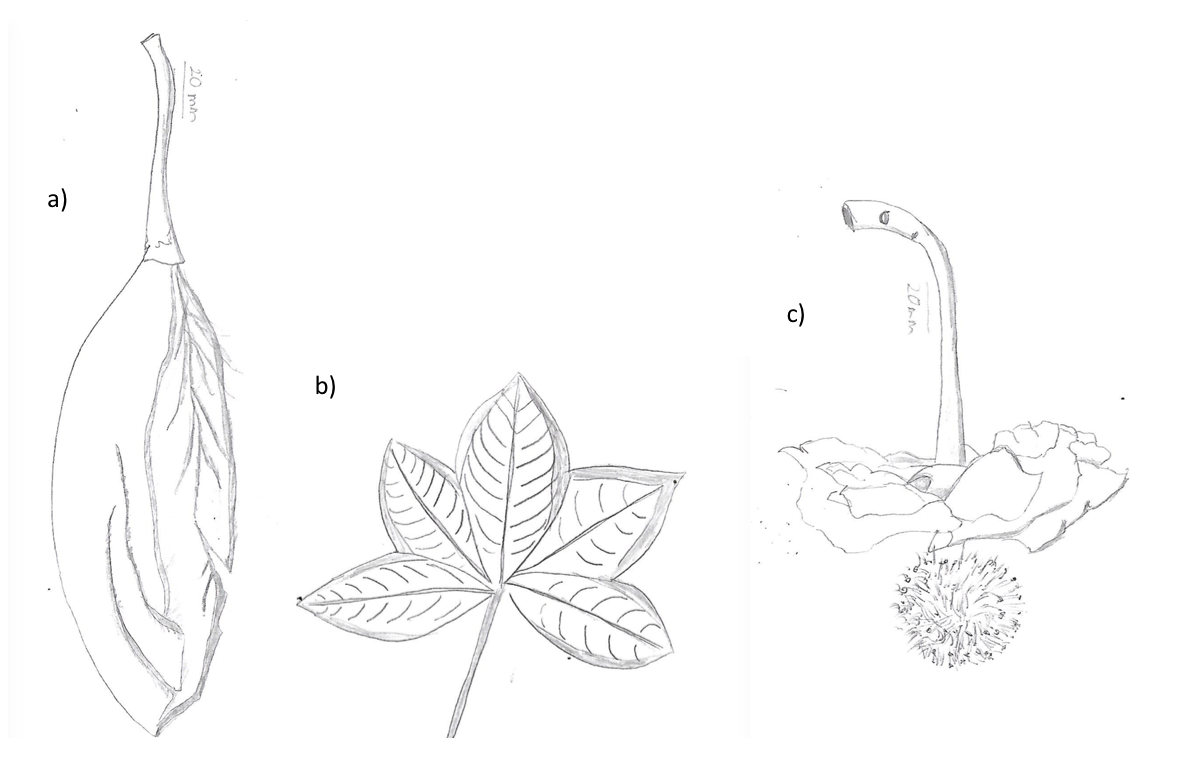 |
| Figure 2: Botanical line drawing illustrating the diagnostic features of Adansonia digi- tata (Baobab). [7] Redrawn and adapted by Lim Wan Xin. |
a)Tip of leafy shoot
b)Flowers of A. digitata where the petals are strongly reflexed
c)Opened fruit
Plant Morphology:
Trunk: Trunk size could reach up to 28m wide, although on average it will grow to around 10m. Bark are found to be thick and fibrous with reistant to fire and drought. Bark are smooth, reddish-brown, greyish-brown or purplish-grey bark
Foliage: Leaves of young trees are often simple. Leaves are 2 foliate at the start of the season and they are early deciduous. More mature ones are 5 foliate. Leaves are alternate at the ends of branches or occur on short spurs on the trunk. Leaflets are sessile to shortly petiolulate with great variation in size. Overall mature leaf size may reach a diameter of 20 cm.
| Image 4: Each leaf comprises five leaflet. (Photo credits: Lim Wan Xin) [8] |
Flowers: Pendulous with five white petals, unpleasant scent, measuring about 20 cm wide, pendulous and solitary in axillary positions, petals large and crinkly.
![Image 5: "Open flower of Baobab Tree" taken by Adamari. [9] Image 5: "Open flower of Baobab Tree" taken by Adamari. [9]](https://upload.wikimedia.org/wikipedia/commons/4/4a/Adansonia_digitata_0013.jpg) |
| Image 5: "Open flower of Baobab Tree" taken by Adamari. [9] |
Fruit: Pulp-containing fruits are apex-pointed, covered by velvety pale yellow-brown hairs with smooth dark brown to blackish seeds covered by cream- coloured kernels.
(2)
![Image 6: "Fruit of the Baobab" taken by Alex Antener. [10] Image 6: "Fruit of the Baobab" taken by Alex Antener. [10]](https://upload.wikimedia.org/wikipedia/commons/1/1f/Baobab_Frucht.jpg) |
| Image 6: "Fruit of the Baobab" taken by Alex Antener. [10] |
Biology
Plant Division :Angiosperms (Flowering Seed Plants)
Once it reaches around 30 or 40 years of age, the trunk begins to swell disproportionately to the size of its crown, often reaching 17 m in girth. This species is known to reach about 47 m in girth after 1,000 years, and the age of the largest Baobabs has been estimated at several thousand years
(8)
.
Reproduction
In its native range, it flowers often, but fruits infrequently. The seeds generally take three to five weeks to germinate, while plants grown from seed start flowering after eight to twenty-three years. The flowering period of baobab which is very long can be reduced to less than five years by grafting.Dispersal Biology
The African baobab, Adansonia digitata L, has been well-known to be bat-pollinated. It is well known that its flowers open at night and are pollinated by bats that feed the nectar at night. Although there are other less-known pollinators of the fruit like bushbabies.The pulp of baobab fruit is tasty and nutritious, being a particularly rich source of potassium tartrate, tartaric acid, and vitamin C. The buoyant fruit and tough waterproof pericarp of Adansonia digitata means that dispersal along rivers, on floodwaters, and along strandlines is probably frequent too (5).
Distribution
Baobab is restricted to hot, semi-arid regions, dry woodland and stony places with low rainfall (less than 1500 mm annually). In Sudan, baobabs are most frequently found in the southern part of the country. They thrive on sandy and rocky soils, from the short-grass savannah to the deciduous savannah woodlands. In Kenya, the baobab is a conspicuous feature of different vegetation types such as deciduous bushland, woodland and wooden grassland (5).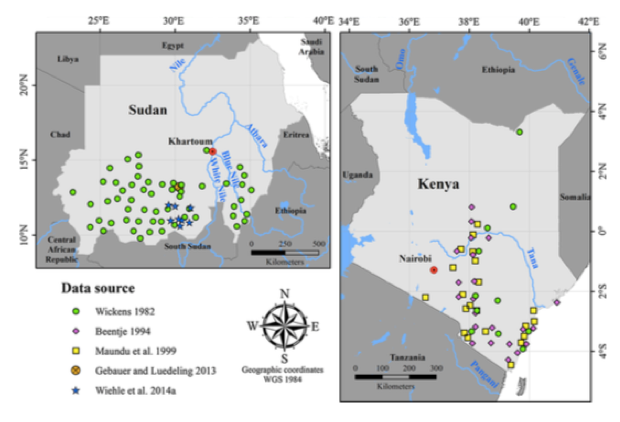 |
| Figure 3 : Distribution of A. digitata in Sudan and Kenya. [11] |
 |
| Figure 4 : Global distribution of A. digitata with 1,096 georeferenced records from 1876 to 2017. [12] |
It is to be noted that the GBIF map is tabulated using georeferenced trees data and might not be an accurate source of worldwide distribution map of a species. From the GBIF map, records of A. digitate could be seen in many places. The species probably originated in West Africa and migrated subsequently throughout the tropical parts of that continent, and beyond, by natural and human-mediated terrestrial and overseas dispersal.
Etymology
==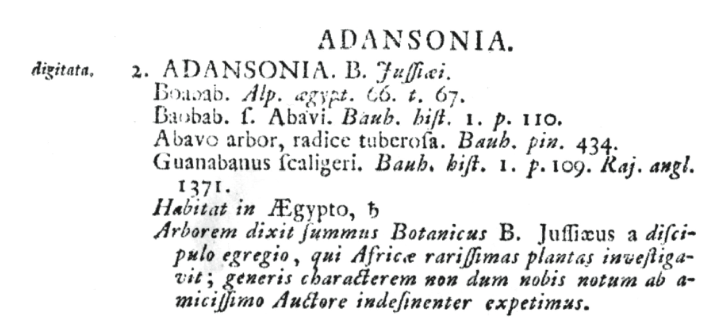 |
| Figure 5: The circumscription of Adansonia digitata in Linnaeus (1753) [14] |
==
The earliest references to the African baobab, Adansonia digitata L., are descriptions of the tree and its water-storage capacity in the travelogue of the 14th-century Arab traveler Ibn Batuta. In the mid 18th century Michel Adanson visited Senegal and provided the first detailed botanical description and illustrations of A. digitate.
The genus name Adansonia was given by Carl von Linne to honour Adanson. The species name digitata means hand-like which is in reference to the shape of its leaves as seen in image 4. The common name “baobab” comes from the Arabic name ‘bu hibab’ which has the meaning of fruits with many seeds. (11). In Sudan, the baobab tree is also called “bottle tree” as it can store up to 10,000 litres of water in its cavities. Hence the baobab tree is an important source of water for Sudanese villages during the dry seasons (12).
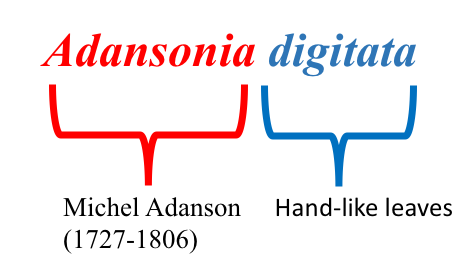
 |
| Table 1: Nonmenclature of Adansonia species. [4] |
=
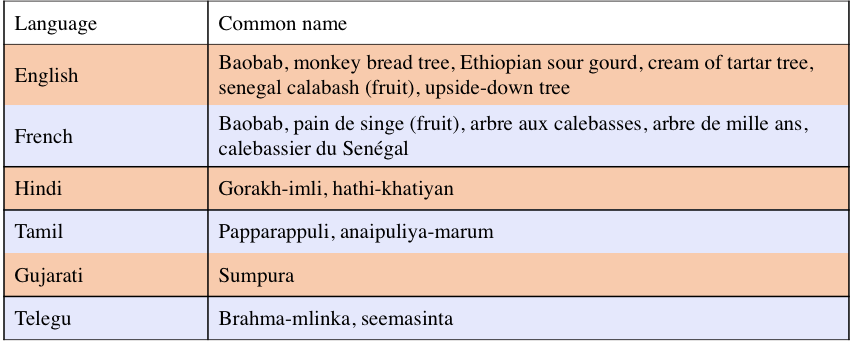 |
| Table 2: Common name for African Baobab. [5] |
Nomenclature
Although the type species, A.digitata, appears in Species Plantarum (Linnaeus, 1753), the generic name was omitted from Genera Plantarum. Hence, the correct date of publication is 1759, when Linnaeus validly published the generic. (13)
Diagnosis
The baobab is a massive deciduous tree easily distinguishable by its huge trunk. It is regarded as the largest succulent plant in the world with a diameter of 10–12 m and a height of 23 m or more. Adansonia digitate can be recognized by its irregular, broad trunks and crowns and had a smooth, reddish-brown bark with large pendulous white flowers. The roots tips are often in the form of tubers. But the main roots of old trees are relatively shallow and rarely extend beyond 2 m depth (13).
A dichotomous key is shown below as an aid for separating out morphologically similar species from the genus Adansonia.
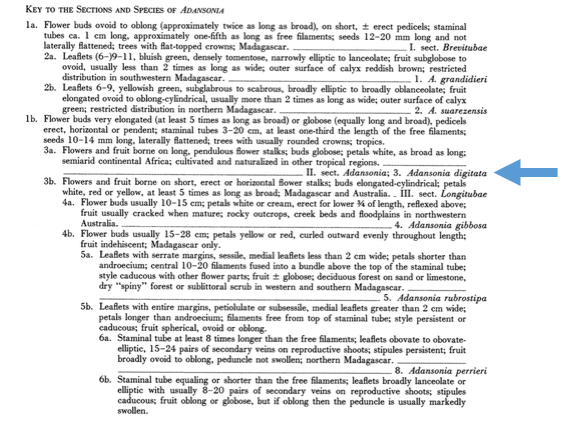 |
| Figure 1: Key to species from Adansonia genus. [6] |
Taxonomy
| Kingdom |
Plantae |
| Phylum |
Tracheophyta |
| Class |
Magnoliopsida |
| Order |
Malvales |
| Family |
Malvaceae |
| Genus |
Adansonia |
| Species |
digitata |
| Scientific Name |
Adansonia digitata L. |
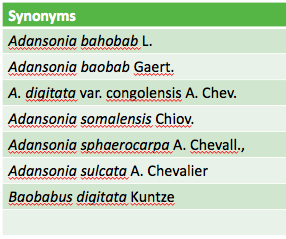
==
==
Type Information
In taxonomy, the holotype is the first specimen used to designate the original description and is usually kept well-guarded in the museum unless there are any needs for retrieval to verify identity of other specimen through comparisons.
Instead, an isotype is a duplicate of the holotype which could be kept in other places and countries further away from the holotype for easier comparison.
Adansonia digitata L.,
Published in Syst. Nat. ed. 10, 2: 1144. 1759. (Baum, 1995).
 |
| Image 7: Preserved Specimen of A.digitata [13] |
A old specimen of A. digita could be found in the Global Biodiversity Information Facility as seen in image 7.
Dataset: The Vascular Plant Collection at the Herbarium Tubingense
Catalogue Number: TUB-002715 / 172116 / 114404
Occurrence ID: http://id.snsb.in...338/172116/114404
Recorded By: Schimper, G.W. (no. 1227)
Phylogeny
Adansonia digitata is one largest and best known of the eight species of Adansonia (13). Of the other seven Adansonia species, one is endemic to northwestern Australia and six are endemic to Madagascar. On the basis of morphology, A. digitata was classified by Baum in 1995 (13) as the only species of section Adansonia, whereas the other seven species were assigned to sections Brevitubae (two species) and Longitubae (five species). Baum based his hypothesis that a group of organism is a species when they share a number of fixed differences from their nearest relatives and contain no subgroups that could be exclusive. This follows because groups that have diagnostic characters that allows them to be isolated from other groups. This hypothesis could be supported by "Biological Species Concept" (18) and the "Phylogenetic Species Concept" (19). Although Baum was not able to find any evidence in taxonomic differences within A.digitata, he did rule out the possibility in the future with better collection of the African species and genealogical analysis of molecular variation.
Apart from Adansonia digitata, the genus is poorly known. Adansonia is almost certainly monophyletic (13). The fruit is unique in the family, consisting of a woody, indehiscent pericarp surrounding numerous, reniform seeds embedded in a chalky or spongy matrix. Similarly, Adansonia is unique in the family in that the calyx encloses the floral buds completely, in contrast to the truncate calyx occurring in other genera. While the anatomy of the African species, A. digitata, is fairly well known little work has been carried out on the Malagasy or Australian species. Clearly, further comparative work is needed.
In 2012, Pettigrew et al. (14) used molecular, morphology, ploidy phylogenetic to discover a new diploid species from African in the baobab genus Adansonia. The genus Adansonia had a distinct geographical distribution. Six species are endemic in Madagascar, while one is endemic in Africa, one in Australia. Two chloroplast DNA markers and the nuclear ITS were used to mark the phylogenetic relationship. Three lineages were observed: one for Malagasy species, one for African species, one for Australian species. Adansonia digitata is the only tetraploid species in the genus Adansonia.
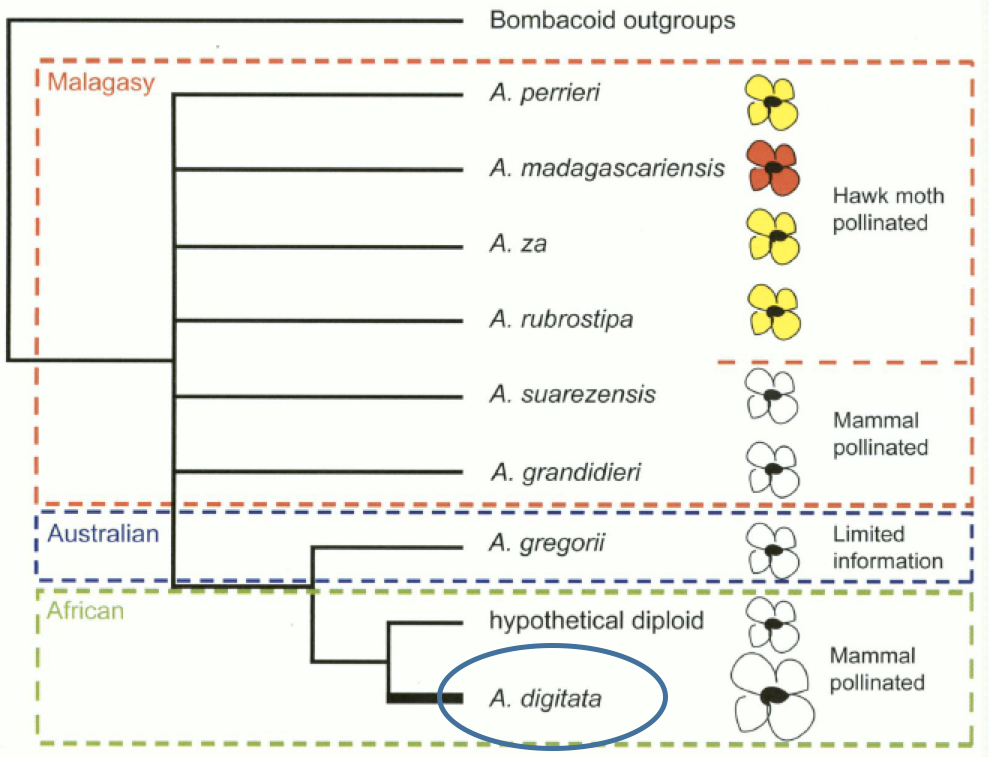 |
| Figure 6: A hypothetical Phylogenetic tree of the Adansonia family. Adapted from Pettigrew et al., 2012. [14] |
In the hypothetical tree shown above, tetraploidy has evolved at the crown of the phytogeny from an unknown diploid progenitor. Since there is no evidence of any tetraploid baobab in Madagascar or Australia, a scenario involving the evolution of a tetraploid baobab in Africa from an African diploid progenitor may be expected.
Pettigrew and his team was able to find a new diploid species found in Africa, Adansonia kilima, which might be the postulated diploid progenitor line, thus providing empirical evidence in support of their hypothesis.
Bootstrap analyses were carried out with 1000 bootstrap replicates, each with 100 heuristic search replicates
Morphological differentiation between the diploid A. Kimilia and the tetraploid A.digitata are shown below in the table
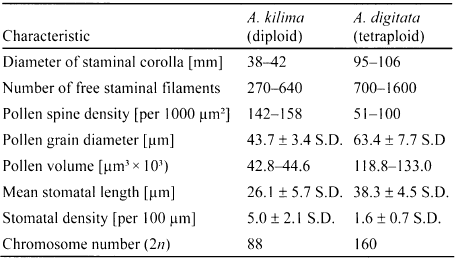 |
| Table 3. Morphological differentiation between the diploid A. Kimilia and the tetraploid A.digitata. [16] |
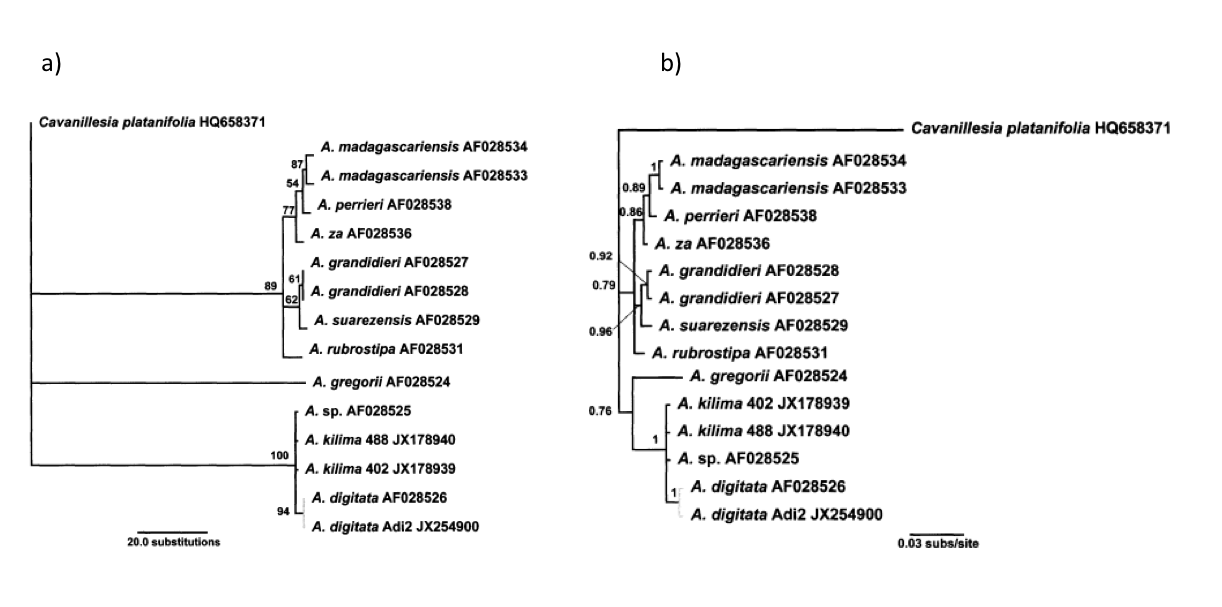 |
| Figure 7: Phylogenetic tree of the Adansonia family.Adapted from Pettigrew et al., 2012. [17](A) Strict consensus of most parsimonious trees based on ITS; (B) Majority rule consensus of trees sampled during Bayesian analysis of ITS. |
The strict consensus of the most parsimonious trees for the ITS sequence (A) and the tree obtained by Bayesian analysis (B) render all three extant areas (Africa, Madagascar and Australia) equally parsimonious as the centre of origin for Adansonia.
The ITS phylogeny demonstrated that A. digitata and A. Kimilia are genetically similar. These are the only tetraploidy species in the genus Adansonia suggesting that tetraploidy evolved relatively recently.
Conclusion
Figure 7’s phylogenetic tree showed a close relationship between A. kilima and A. digitata; and close relationships among the Malagasy species. In addition, the existence of three major subclades within Adansonia, corresponding to the three geographical areas (Africa, Australia, Madagascar), is strongly supported by the ITS phylogeny.
Previous studies based on a combination of chloroplast and nuclear DNA and morphological characters has suggested that albeit weakly, that the Australian and African clades were sisters. Although this could be true, support is too low. Hence additional data is needed to resolve this deep issue.
Literature and References
(1) Kamatou, G. P. P., Vermaak, I., & Viljoen, A. M. (2011). An updated review of Adansonia digitata: A commercially important African tree. South African Journal of Botany, 77(4), 908-919.
(2) Komane, B. M., Vermaak, I., Kamatou, G. P., Summers, B., & Viljoen, A. M. (2017). Beauty in Baobab: a pilot study of the safety and efficacy of Adansonia digitata seed oil. Revista Brasileira de Farmacognosia, 27(1), 1-8.
(3) Nkafamiya, I. I., Osemeahon, S. A., Dahiru, D., & Umaru, H. A. (2007). Studies on the chemical composition and physicochemical properties of the seeds of baobab (Adasonia digitata). African Journal of Biotechnology, 6(6).
(4) Nyam, K. L., Tan, C. P., Lai, O. M., Long, K., & Man, Y. C. (2009). Physicochemical properties and bioactive compounds of selected seed oils. LWT-Food Science and technology, 42(8), 1396-1403.
(5) Wickens, G. E. 1979. The use of the baobab (Adan- sonia digitata) in Africa. Pp. 27-34 in G. Kunkel, Taxonomic Aspects of African Economic Botany, Proceedings of the IX Plenary Meeting of AETFAT. Excmo. Ayuntamiento, Las Palmas de Gran Canaria, Canary Islands.
(6) Swart, E. R. (1963). Age of the baobab tree. Nature, 198(4881), 708-709.
(7) Kaboré, D., Sawadogo-Lingani, H., Diawara, B., Compaoré, C. S., Dicko, M. H., & Jakobsen, M. (2011). A review of baobab (Adansonia digitata) products: effect of processing techniques, medicinal properties and uses. African Journal of Food Science, 5(16), 833-844.
(8) Rahul, J., Jain, M. K., Singh, S. P., Kamal, R. K., Naz, A., Gupta, A. K., & Mrityunjay, S. K. (2015). Adansonia digitata L.(baobab): a review of traditional information and taxonomic description. Asian Pacific Journal of Tropical Biomedicine, 5(1), 79-84.
(9) Sankaranarayanan, S., Bama, P., Ramach, J., Kalaichelvan, P. T., Deccaraman, M., Vijayalakshimi, M., ... & Bama, S. S. (2010). Ethnobotanical study of medicinal plants used by traditional users in Villupuram district of Tamil Nadu, India. Journal of Medicinal Plants Research, 4(12), 1089-1101.
(10)De Caluwé, E., Halamová, K., & Van Damme, P. (2017). Adansonia digitata L.–A review of traditional uses, phytochemistry and pharmacology. Afrika focus, 23(1).
(11)Mshigenro, K. E., & Paull, R. E. (2008). Adansonia digitata, baobab. The encyclopedia of fruits & nuts. Janick J, Paull RE (eds), Cambridge University Press, USA.
(12)Gebauer, J., Adam, Y. O., Sanchez, A. C., Darr, D., Eltahir, M. E., Fadl, K. E., ... & Hunsche, M. (2016). Africa’s wooden elephant: the baobab tree (Adansonia digitata L.) in Sudan and Kenya: a review. Genetic resources and crop evolution, 63(3), 377-399.
(13)Baum, D. A. (1995). A systematic revision of Adansonia (Bombacaceae). Annals of the Missouri Botanical Garden, 440-471.
(14)Pettigrew, F. R. S., Jack, D., Bell, K. L., Bhagwandin, A., Grinan, E., Jillani, N., ... & Vickers, C. E. (2012). Morphology, ploidy and molecular phylogenetics reveal a new diploid species from Africa in the baobab genus Adansonia (Malvaceae: Bombacoideae). Taxon, 61(6), 1240-1250.
(15)Van den Bilcke, N., De Smedt, S., Simbo, D. J., & Samson, R. (2013). Sap flow and water use in African baobab (Adansonia digitata L.) seedlings in response to drought stress. South African journal of botany, 88, 438-446.
(16)TSY, P., LEONG, J. M., LUMARET, R., MAYNE, D., VALL, A. O. M., ABUTABA, Y. I., ... & DANTHU, P. (2009). Chloroplast DNA phylogeography suggests a West African centre of origin for the baobab, Adansonia digitata L.(Bombacoideae, Malvaceae). Molecular Ecology, 18(8), 1707-1715.
(17)Ravi, V., Khurana, J. P., Tyagi, A. K., & Khurana, P. (2008). An update on chloroplast genomes. Plant Systematics and Evolution, 271(1-2), 101-122.
(18)Mayr, E. (2000). The biological species concept. Species concepts and phylogenetic theory: a debate. Columbia University Press, New York, 17-29.
(19)Nixon, K. C., & Wheeler, Q. D. (1990). An amplification of the phylogenetic species concept. Cladistics, 6(3), 211-223.
Image and Figures Resources:
| Image Sources |
License |
| [1] Image 1: "Baobab and elephant in Tanzania" by Ferdinand Reus. URL:https://en.wikipedia.org/wiki/File:Baobab_and_elephant,_Tanzania.jpg (accessed on 12 Nov 2017). |
CC BY-SA 2.0. |
| [2] Image 2: "The Tree of Life" in the Lion King movies. URL: http://disney.wikia.com/wiki/Rafiki%27s_Ancient_Tree. Accessed on 15 Nov 2017. |
CC BY-SA 2.0. |
| [3] Image 3: Heritage Tree of Adansonia digitata found in Singapore Botanical Garden. |
Photo credits: Lim Wan Xin |
| [4] Table 1: Nonmenclature of Adansonia species. Adapted from "Adansonia digitata L.(baobab): a review of traditional information and taxonomic description" (Rahul et al.,2015). Table created by Lim Wan Xin. |
Fair Use |
| [5] Table 2: Common name for African Baobab. Adapted from "Adansonia digitata L.(baobab): a review of traditional information and taxonomic description" (Rahul et al.,2015). Table created by Lim Wan Xin. |
Fair Use |
| [6] Figure 1: Key to species from Adansonia genus adapted from "A Systematic Revision of Adansonia (Bombacaceae)" (Baum,1995) Annotated by Lim Wan Xin |
Fair Use |
| [7] Figure 2: Botanical line drawing illustrating the diagnostic features of Adansonia digi- tata (Baobab). Adapted from "Beauty in Baobab: a pilot study of the safety and efficacy of Adansonia digitata seed oil" (Adapted from Komant et al., 2017). |
Illustrated by Lim Wan Xin. |
| [8] Image 4: Each leaf comprises five leaflet. |
Photo credits: Lim Wan Xin |
| [9] Image 5: "Open flower of Baobab Tree" taken by Adamari. URL: https://en.wikipedia.org/wiki/File:Adansonia_digitata_0013.jpg (accessed on 15 Nov 2017). |
CC BY-SA 3.0 |
| [10]Image 6: "Fruit of the Baobab" taken by Alex Antener. URL: https://en.wikipedia.org/wiki/File:Baobab_Frucht.jpg (accessed on 15 Nov 2017). |
CC BY-SA 3.0 |
| [11] Figure 3 : Distribution of A. digitata in Sudan and Kenya. Adapted from "Africa’s wooden elephant: the baobab tree" (Gebauer et al., 2016). |
Fair Use |
| [12] Figure 4 : Global distribution of A. digitata with 1,096 georeferenced records. URL: https://www.gbif.org/dataset/ab1de8e9-8a18-4ffe-b2c6-e13ffbec3e7e. Accessed on 15 Nov 2017. Adansonia digitata L. in GBIF Secretariat (2017). GBIF Backbone Taxonomy. Checklist Dataset https://doi.org/10.5072/hufs9m accessed via GBIF.org on 2017-11-15. |
CC BY 4.0 |
| [13] Preserved Specimen of A.digitata. URL: http://pictures.snsb.info/TUBafrplantscoll/web/TUB-0027/TUB-002715_20070118_142807.jpg (accessed on 15 Nov 2017). Dataset: The Vascular Plant Collection at the Herbarium Tubingense Catalogue Number: TUB-002715 / 172116 / 114404 Occurrence ID: http://id.snsb.in...338/172116/114404 Recorded By: Schimper, G.W. (no. 1227) |
CC BY 4.0 |
| [14] The circumscription of Adansonia digitata in Linnaeus (1753) |
Fair Use |
| [15] Figure 6: Hypothetical Phylogenetic tree of the Adansonia family. [14] Adapted from Pettigrew et al., 2012. Annotated by Lim Wan Xin. |
Fair Use |
| [16] Table 3: Morphological differentiation between the diploid A. Kimilia and the tetraploid A.digitata. Adapted from Pettigrew et al., 2012. |
Fair Use |
| [17] Figure 7: Phylogenetic tree of the Adansonia family. Adapted from Pettigrew et al., 2012. Annotated by Lim Wan Xin. |
Fair Use |